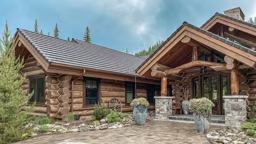
Building a log home that’s easy on your wallet starts well before you break ground. Save loads of money in the design phase by following these hints gleaned from log home experts. 1. Minimize corners and bump-outs: Instead, go with a rectangular floorplan to save money. “More corners require more workmanship to create the notches, and you’ll also have more wasted materials,” explains Dorie Workman at Appalachian Log Structures in Ripley, West Virginia. Stick with a four-corner home to trim the work neccessary to build the walls while maximizing the logs used, so construction will be quicker and cheaper for you. 2. Choose standard-size windows and doors—but don’t scrimp on quality: Costs can rise quickly when you select windows and doors in unique sizes, shapes and colors. Types of windows also vary in price, says Mary Beth Smith-Brown, a designer at Tennessee Log Homes, in Athens, Tennessee.
“Casement windows often cost more than double-hung windows,” she says. “But using a high-quality double-hung window is certainly more cost- effective in the long run than using a cheaper, low-quality casement window.” 3. Select your site carefully: Where you decide to site your home can have a huge impact on your bottom line. Dorie suggests building close to a road and established utilities. Otherwise, homeowners have to pick up the tab for long, winding driveways and other costs like septic, sewage and electricity. Level, unwooded plots also are less expensive to build on, since there’s no clearing costs to consider. 4. Use a simple, low-pitch roof: How complicated your floorplan is often determines how involved your rooflines (view 8 of the most common roof configurations for log homes here) are.
Multiple rooflines or opting for a steeper roof will increase your budget. Mary Beth recommends clients evaluate how much space is required on their second level and have that determine the pitch of the roof. “Using a 10/12 roof pitch versus a 12/12 can often save you money in material, labor and finishing costs,” she says. 5. Opt for an open floorplan: Decorative items that fit a season can bring color and charm to your home. However, be careful with holiday-themed items—such as figurines with pumpkin faces for Halloween—as they can’t be used year round and can date your space. Instead, inject the seasons with cues from nature.








_11868_2024-09-17_08-44-256x288.avif)


